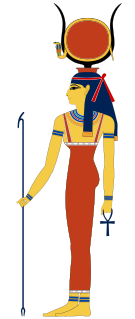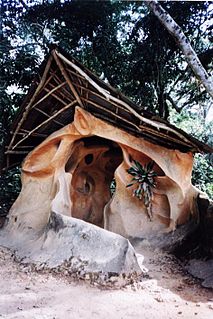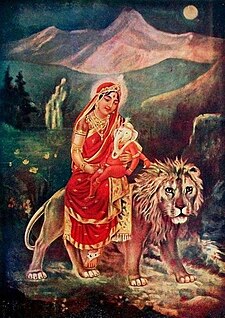 W
WAl-ʻUzzā was one of the three chief goddesses of Arabian religion in pre-Islamic times and was worshiped by the pre-Islamic Arabs along with al-Lāt and Manāt. A stone cube at Nakhla was held sacred as part of her cult. She is mentioned in Qur'an 53:19 as being one of the goddesses that people worshiped.
 W
WAstarte is the Hellenized form of the Ancient Near Eastern goddess Astoreth, a form of Ishtar, worshipped from the Bronze Age through classical antiquity. The name is particularly associated with her worship in the ancient Levant among the Canaanites and Phoenicians. She was also celebrated in Egypt following the importation of Levantine cults there. The name Astarte is sometimes also applied to her cults in Mesopotamian cultures like Assyria and Babylonia.
 W
WBabalon is a goddess found in the occult system of Thelema, which was established in 1904 with the writing of The Book of the Law by English author and occultist Aleister Crowley. The spelling of the name as 'Babalon' was revealed to Crowley in The Vision and the Voice. Her name and imagery feature prominently in Crowley's Liber Cheth vel Vallum Abiegni.
 W
WBranwen, Daughter of Llŷr is a major character in the Second Branch of the Mabinogi, which is sometimes called the "Mabinogi of Branwen" after her.
 W
WErzulie is a family of loa, or spirits, in Vodou.
 W
WIn Norse mythology, Freyja is a goddess associated with love, beauty, fertility, sex, war, gold, and seiðr. Freyja is the owner of the necklace Brísingamen, rides a chariot pulled by two cats, is accompanied by the boar Hildisvíni, and possesses a cloak of falcon feathers. By her husband Óðr, she is the mother of two daughters, Hnoss and Gersemi. Along with her twin brother Freyr, her father Njörðr, and her mother, she is a member of the Vanir. Stemming from Old Norse Freyja, modern forms of the name include Freya, Freyia, and Freja.
 W
WFrigg is a goddess in Germanic mythology. In Norse mythology, the source of most surviving information about her, she is associated with foresight and wisdom, and dwells in the wetland halls of Fensalir. In wider Germanic mythology, she is known in Old High German as Frīja, in Langobardic as Frēa, in Old English as Frīg, in Old Frisian as Frīa, and in Old Saxon as Frī, all ultimately stemming from the Proto-Germanic theonym *Frijjō, meaning '(the) Beloved' or '(the) Free'. Nearly all sources portray her as the wife of the god Odin.
 W
W*Frijjō ("Frigg-Frija") is the reconstructed name or epithet of a hypothetical Common Germanic love goddess, the most prominent female member of the *Ansiwiz (gods), and often identified as the spouse of the chief god, *Wōdanaz (Woden-Odin).
 W
WPomba Gira is the name of an Afro-Brazilian spirit evoked by practitioners of Umbanda and Quimbanda in Brazil. She is the consort of Exu, who is the messenger of the Orixas in Candomblé. Known by many names, or avatars, Pomba Gira is often associated with the number seven, crossroads, graveyards, spirit possession, and witchcraft.
 W
WHathor was a major goddess in ancient Egyptian religion who played a wide variety of roles. As a sky deity, she was the mother or consort of the sky god Horus and the sun god Ra, both of whom were connected with kingship, and thus she was the symbolic mother of their earthly representatives, the pharaohs. She was one of several goddesses who acted as the Eye of Ra, Ra's feminine counterpart, and in this form she had a vengeful aspect that protected him from his enemies. Her beneficent side represented music, dance, joy, love, sexuality and maternal care, and she acted as the consort of several male deities and the mother of their sons. These two aspects of the goddess exemplified the Egyptian conception of femininity. Hathor crossed boundaries between worlds, helping deceased souls in the transition to the afterlife.
 W
WHuitaca or Xubchasgagua was a rebelling goddess in the religion of the Muisca. The Muisca and their confederation were one of the four advanced civilizations of the Americas who inhabited the Altiplano Cundiboyacense in the Andes. Huitaca has been described by the chroniclers Juan de Castellanos in his Elegías de varones ilustres de Indias, Lucas Fernández de Piedrahita and Pedro Simón.
 W
WInanna is an ancient Mesopotamian goddess associated with love, beauty, sex, war, justice and political power. She was originally worshiped in Sumer under the name "Inanna", and was later worshipped by the Akkadians, Babylonians, and Assyrians under the name Ishtar. She was known as the "Queen of Heaven" and was the patron goddess of the Eanna temple at the city of Uruk, which was her main cult center. She was associated with the planet Venus and her most prominent symbols included the lion and the eight-pointed star. Her husband was the god Dumuzid and her sukkal, or personal attendant, was the goddess Ninshubur.
 W
WMami Wata is a water spirit venerated in West, Central, and Southern Africa, and in the African diaspora in the Americas. Mami Wata spirits are usually female, but are sometimes male.
 W
WMaría Lionza is the central figure in one of the most widespread indigenous religions in Venezuela. The cult of María Lionza is a blend of African, indigenous and Catholic beliefs. She is revered as a goddess of nature, love, peace and harmony. She has followers throughout Venezuelan society, from small rural villages to Caracas, where a monumental statue stands in her honor. The Cerro María Lionza Natural Monument where an important pilgrimage takes place every October, was named in her honour.
 W
WMilda, in the Lithuanian mythology, is the goddess of love. However, her authenticity is debated by scholars. Despite the uncertainty, Milda became a popular female given name in Lithuania. Neo-pagan societies and communities, including Romuva, organize various events in honor of goddess Milda in May. The Milda Mons, a mountain on Venus, is named after her. The female figure at the top of the Freedom Monument in Riga is affectionately called Milda, because for the sculpture posed Lithuanian woman Milda Jasikienė, who lived in Riga and was an ideal of beauty for the author of the monument – Kārlis Zāle.
 W
WNanaya is the canonical name for a goddess worshipped by the Sumerians and Akkadians, a deity who personified voluptuousness and sexuality, and warfare. Her cult was large and was spread as far as Egypt, Syria, and Iran. She later became syncretised as an aspect of Inanna.
 W
WỌṣun, is an Orisha, a spirit, a deity, or a goddess that reflects one of the manifestations of the Yorùbá Supreme Being in the Ifá oral tradition and Yoruba-based religions of West Africa. She is one of the most popular and venerated Orishas. Oshun is an important river deity among the Yorùbá people. She is the goddess of divinity, femininity, fertility, beauty and love. She is connected to destiny and divination.
 W
WParvati, Uma or Gauri is the Hindu goddess of fertility, love, beauty, harmony, marriage, children, and devotion; as well as of divine strength and power. Known by many other names, she is the gentle and nurturing form of the Supreme Hindu goddess Adi Parashakti and one of the central deities of the Goddess-oriented Shakti sect called Shaktism. She is the Mother goddess in Hinduism, and has many attributes and aspects. Along with Lakshmi and Saraswati, she forms the trinity of Hindu goddesses (Tridevi).
 W
WIn Greek mythology, Peitho is the goddess who personifies persuasion and seduction. Her Roman equivalent is Suada or Suadela. She is typically presented as an important companion of Aphrodite. Her opposite is Bia, the personification of force. As a personification, she was sometimes imagined as a goddess and sometimes an abstract force with her name used both as a common and proper noun. There is evidence that Peitho was referred to as a goddess before she was referred to as an abstract concept, which is rare for a personification. Peitho represents both sexual and political persuasion.
 W
WPrende is the goddess of love, beauty and fertility in the Albanian pagan mythology, who is thought to have been worshiped by the Illyrians in antiquity. In Albanian folklore she is the wife of the thunder and sky god Perëndi, and referred to as "Lady Prenne" or "Lady of Beauty", while her sacred day was Friday, named in Albanian after her: e premte. Prende is identified with the cult of Venus and she was worshipped in northern Albania, especially by the Albanian women, until recent times. Originally a pre-Christian deity, she was called "Saint Veneranda" (Shënepremte), identified by the Catholic Church as Saint Anne, mother of Virgin Mary. She was so popular in Albania that over one in eight of the Catholic churches existing in the late 16th and the early 17th centuries were named after her. Many other historical Catholic and Orthodox churches were dedicated to her in the 18th and 19th centuries.
 W
WQetesh is a goddess, who was adopted during the late Bronze Age from the religion of Canaan into the ancient Egyptian religion during its New Kingdom. She was a fertility goddess of sacred ecstasy and sexual pleasure, and became a popular deity.
 W
WRati is the Hindu goddess of love, carnal desire, lust, passion and sexual pleasure. Usually described as the daughter of Prajapati Daksha, Rati is the female counterpart, the chief consort and the assistant of Kama (Kamadeva), the god of love. A constant companion of Kama, she is often depicted with him in legend and temple sculpture. She also enjoys worship along with Kama.
 W
WIn Aztec mythology, Tlazolteotl is a deity of vice, purification, steam baths, lust, filth, and a patroness of adulterers. She is known by three names, Tlahēlcuāni and Tlazōlmiquiztli, and Ixcuina or Ixcuinan, the latter of which refers to a quadripartite association of four sister deities.
 W
WTuran was the Etruscan goddess of love, fertility and vitality and patroness of the city of Velch.
 W
WVenus is a Roman goddess, whose functions encompassed love, beauty, desire, sex, fertility, prosperity and victory. In Roman mythology, she was the ancestor of the Roman people through her son, Aeneas, who survived the fall of Troy and fled to Italy. Julius Caesar claimed her as his ancestor. Venus was central to many religious festivals, and was revered in Roman religion under numerous cult titles.
 W
WIn Aztec mythology, Xochiquetzal, also called Ichpochtli Classical Nahuatl: Ichpōchtli [itʃˈpoːtʃtɬi], meaning "maiden", was a goddess associated with fertility, beauty, and female sexual power, serving as a protector of young mothers and a patroness of pregnancy, childbirth, and the crafts practiced by women such as weaving and embroidery. In pre-Hispanic Maya culture, a similar figure is Goddess I.